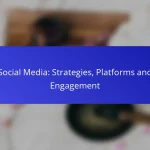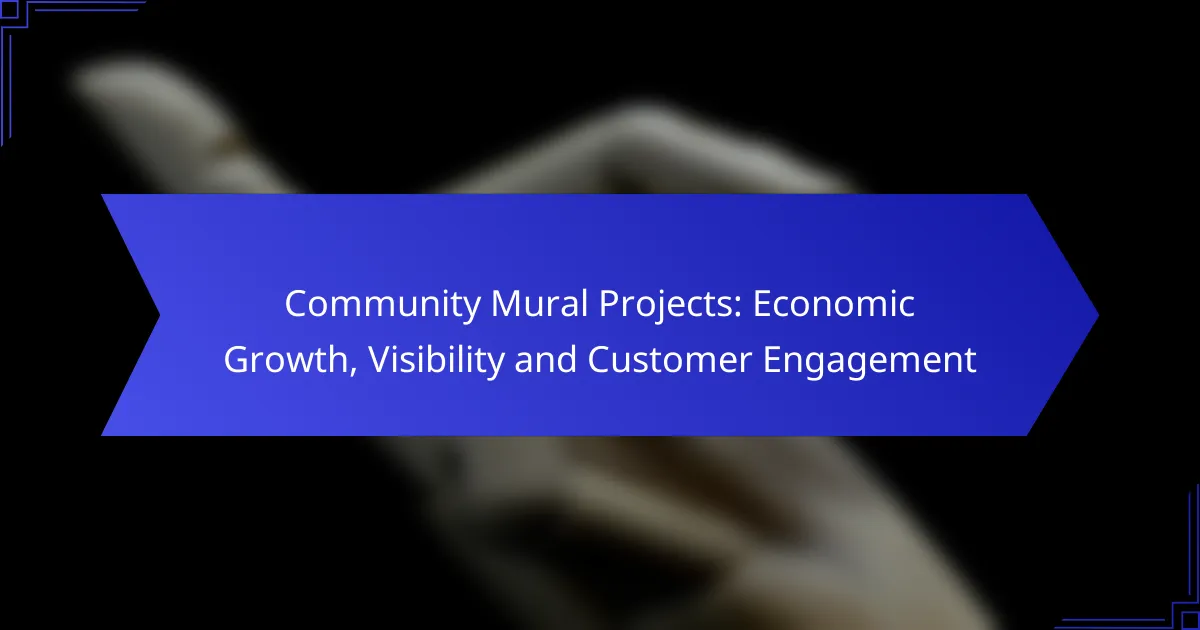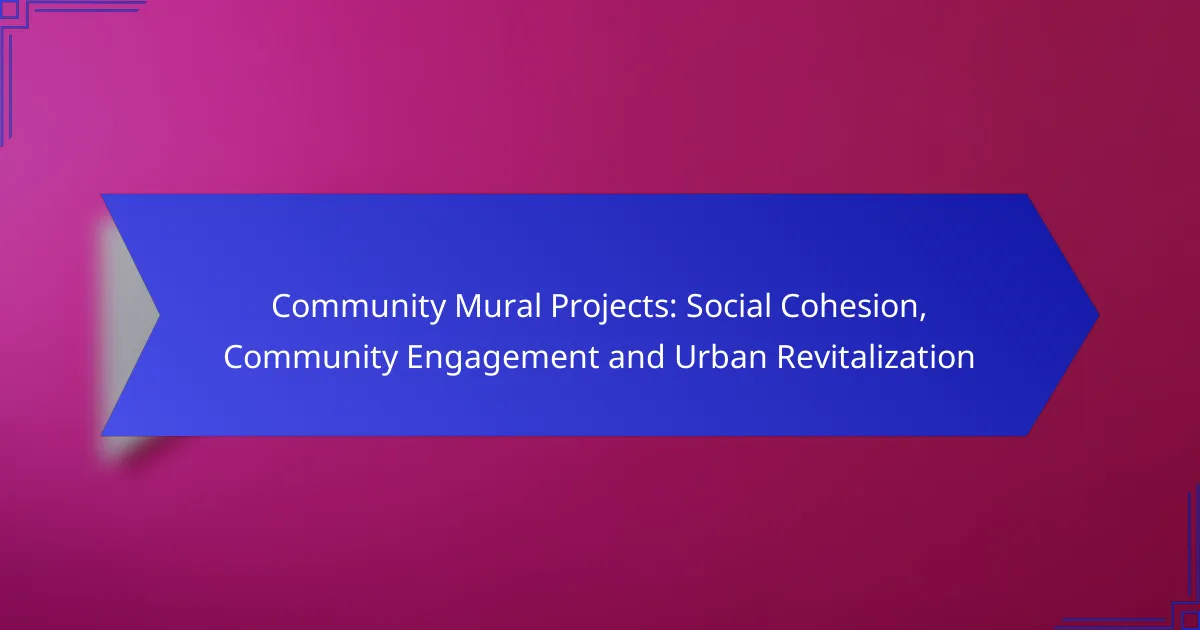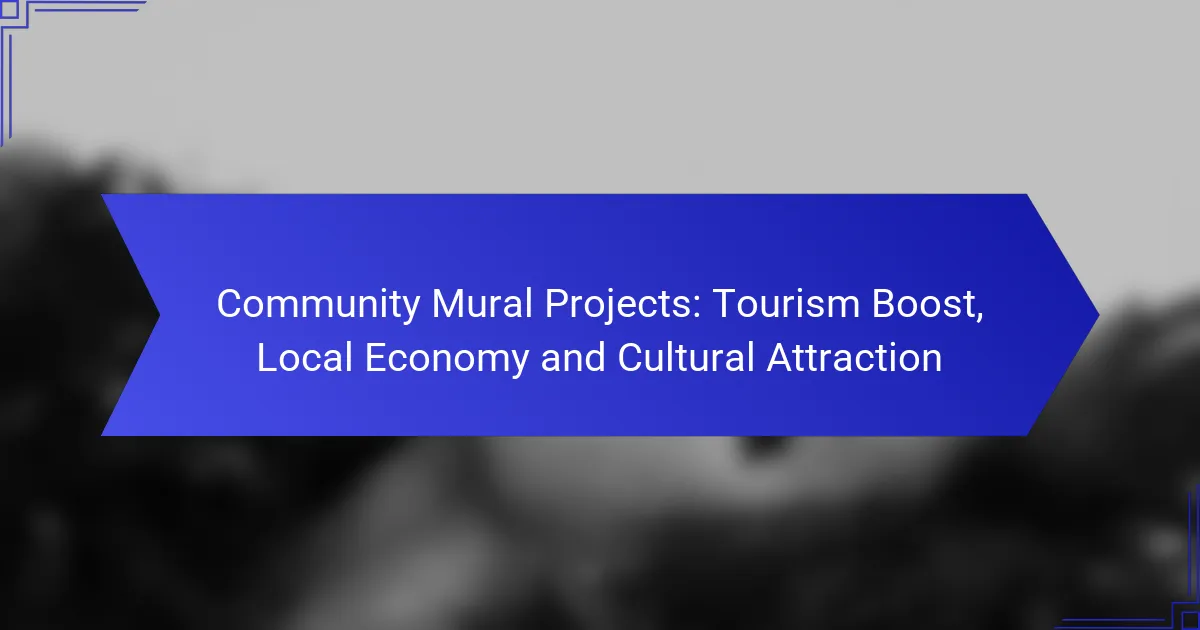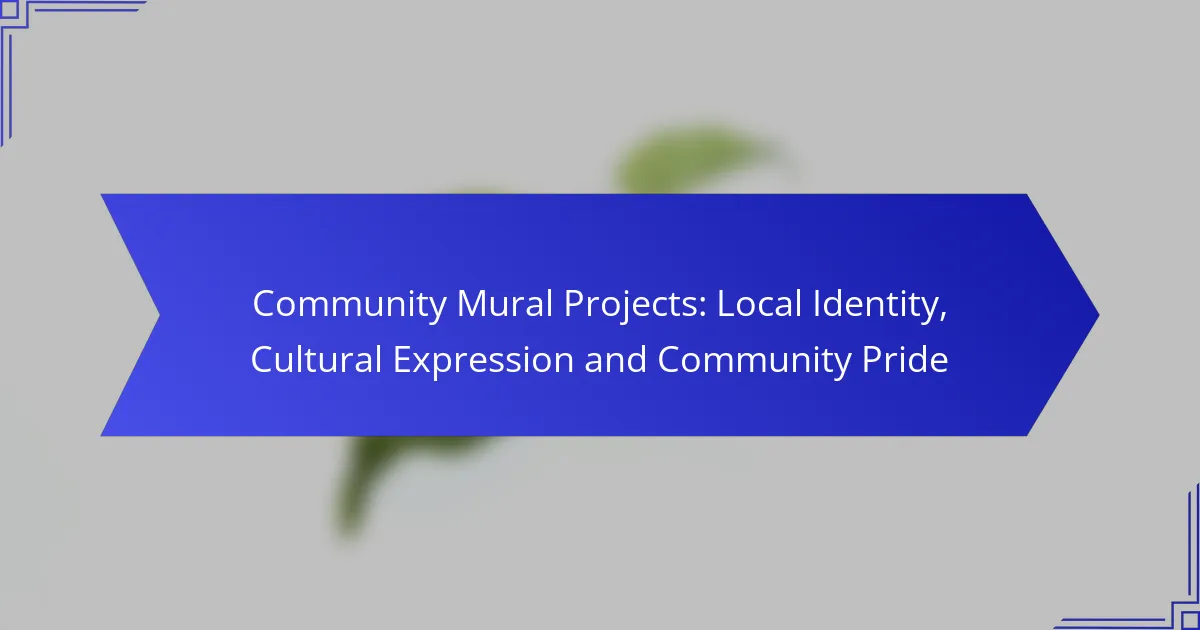Community mural projects play a vital role in stimulating economic growth by boosting local visibility and attracting customers to the area. By transforming public spaces into vibrant art showcases, these murals enhance foot traffic and create a dynamic environment that encourages spending and investment. Additionally, they foster customer engagement by reflecting community values and promoting interaction, ultimately strengthening the connection between businesses and their patrons.

How do community mural projects drive economic growth?
Community mural projects stimulate economic growth by enhancing local visibility, attracting customers, and fostering a vibrant arts scene. These initiatives create a dynamic environment that encourages spending and investment in the community.
Increased local business revenue
Mural projects often lead to increased local business revenue by drawing foot traffic and enhancing the overall aesthetic appeal of an area. Businesses located near murals frequently report higher sales, as visitors are more likely to stop and shop in visually engaging environments.
For example, a café situated next to a popular mural may see a boost in customers, especially if the mural becomes a social media hotspot. Local businesses can capitalize on this by offering promotions or events that tie in with the mural’s theme.
Attraction of tourism and visitors
Community murals serve as attractions that can significantly boost tourism and visitor numbers. Unique and vibrant murals can become landmarks, encouraging both locals and tourists to explore the area, often leading to longer stays and increased spending.
Regions known for their street art, such as Wynwood in Miami, demonstrate how murals can transform neighborhoods into tourist destinations. Communities should consider promoting mural tours or events to further capitalize on this interest.
Job creation in the arts sector
Community mural projects contribute to job creation in the arts sector by providing opportunities for local artists, designers, and construction workers. These projects often require skilled labor for mural creation, installation, and maintenance, fostering a thriving creative economy.
Additionally, local governments and organizations may offer grants or funding for mural projects, which can lead to further job opportunities in related fields such as marketing and event planning. Engaging local artists not only supports the economy but also enriches the community’s cultural fabric.

What visibility benefits do community murals provide?
Community murals enhance visibility by transforming public spaces into vibrant art showcases, attracting attention from both locals and visitors. These murals serve as visual landmarks that can significantly increase foot traffic and awareness for nearby businesses.
Enhanced brand recognition for local businesses
Murals can act as powerful marketing tools for local businesses by integrating their branding into the artwork. When a mural features a business’s logo or theme, it creates a memorable association that can lead to increased customer loyalty and recognition.
For example, a café might commission a mural that reflects its brand identity, making it a focal point for passersby. This can lead to a noticeable uptick in patrons, especially if the mural is strategically located in a high-traffic area.
Promotion of local culture and identity
Community murals often celebrate local culture, history, and identity, fostering a sense of pride among residents. By depicting significant cultural symbols or historical events, these artworks can resonate deeply with the community, enhancing local engagement.
In cities like Sofia, murals that reflect Bulgarian folklore or historical figures can attract both locals and tourists, creating a unique cultural experience. This not only boosts community pride but also positions the area as a cultural destination.
Improved social media engagement
Murals provide excellent opportunities for social media engagement, as people love to share visually striking images. Businesses can encourage customers to take photos with the mural, tagging their location and boosting online visibility.
Creating a dedicated hashtag for the mural can further enhance this effect, allowing businesses to track engagement and reach a wider audience. For instance, a local brewery might see increased social media mentions and shares simply by having a mural that patrons find photogenic.

How can businesses engage customers through mural projects?
Businesses can engage customers through mural projects by creating visually appealing art that reflects community values and encourages interaction. These projects not only enhance the aesthetic of the area but also foster a sense of belonging and connection among customers.
Hosting mural-related events and workshops
Hosting events and workshops centered around mural creation can attract customers and build community ties. For instance, businesses can organize mural painting days where customers participate alongside artists, creating a shared experience that strengthens relationships.
Consider offering workshops that teach mural painting techniques or art appreciation. These can be ticketed events, providing an additional revenue stream while engaging customers in a creative process.
Collaborating with local artists for community involvement
Collaborating with local artists not only supports the community but also enhances the authenticity of the mural projects. Businesses can invite artists to design murals that reflect local culture, history, or themes that resonate with the community.
Establish partnerships with local art schools or collectives to identify emerging talent. This collaboration can lead to unique, vibrant murals that draw attention and encourage local patronage.
Creating interactive mural experiences
Interactive murals can significantly boost customer engagement by inviting participation. Businesses can incorporate elements like QR codes that link to stories about the mural or augmented reality features that enhance the viewing experience.
Consider designing murals that encourage physical interaction, such as photo spots or areas where customers can add their own artistic touches. These features can create memorable experiences that customers are likely to share on social media, further promoting the business.
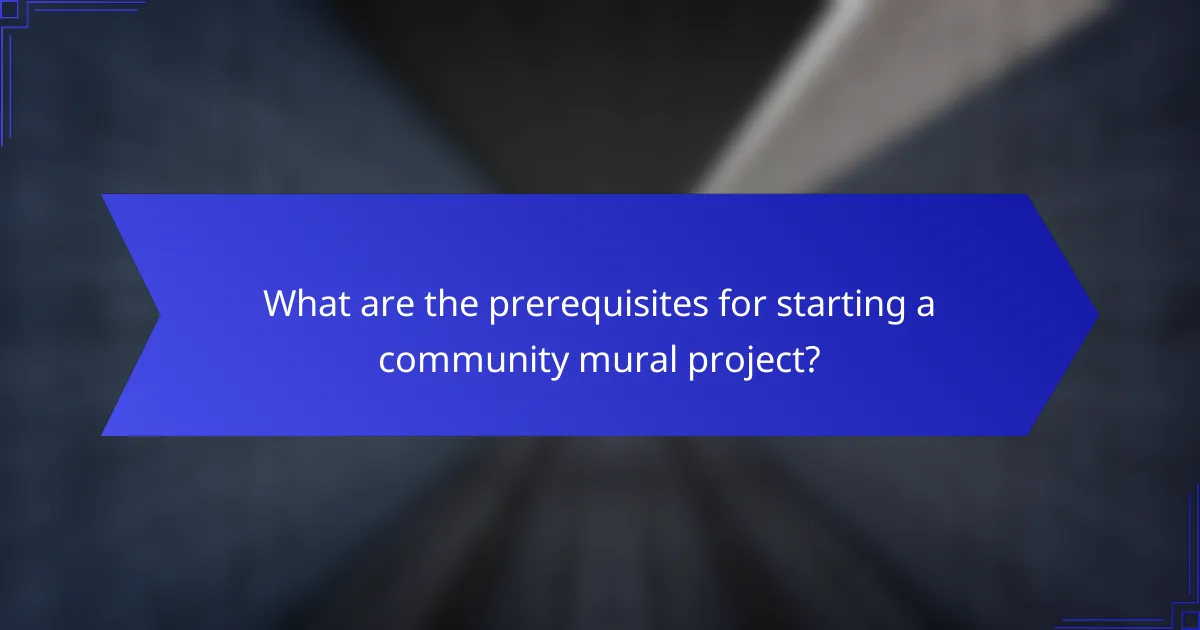
What are the prerequisites for starting a community mural project?
Starting a community mural project requires careful planning, including securing funding and obtaining necessary permits. These steps are crucial to ensure the project’s success and compliance with local regulations.
Securing funding and sponsorship
Funding is essential for any community mural project, as it covers materials, artist fees, and promotional activities. Consider approaching local businesses, community organizations, and art grants for financial support.
When seeking sponsorship, create a compelling proposal that outlines the project’s benefits for the community and potential visibility for sponsors. Offering recognition through signage or promotional materials can enhance the appeal for potential funders.
Obtaining necessary permits and approvals
Before starting a mural, it’s important to check local regulations regarding public art. This often involves obtaining permits from city or municipal authorities, which may require submitting designs for approval.
Engage with local government offices early in the process to understand the specific requirements and timelines for permits. Failure to secure the necessary approvals can lead to project delays or legal issues, so thorough preparation is key.

How can businesses measure the impact of mural projects?
Businesses can measure the impact of mural projects through various methods, focusing on foot traffic, sales data, and community engagement. By analyzing these factors, companies can gain insights into how murals influence customer behavior and overall economic growth.
Tracking foot traffic and sales data
To assess the impact of mural projects, businesses should track foot traffic using tools like people counters or mobile tracking apps. An increase in visitors can indicate heightened interest generated by the mural, which can be correlated with sales data to evaluate financial impact.
For example, a business might compare sales figures before and after a mural installation. If sales increase by 15-30% in the months following the mural’s unveiling, this suggests a positive correlation between the artwork and customer engagement.
Gathering community feedback and surveys
Collecting community feedback through surveys can provide valuable insights into public perception of the mural. Businesses can distribute surveys both online and in-store, asking customers about their awareness of the mural and its influence on their decision to visit.
In addition to quantitative data, qualitative feedback can highlight specific elements that resonate with the community. For instance, comments about the mural’s theme or artist can guide future projects and enhance customer connection. Aim for a response rate of at least 10-20% to ensure reliable data.
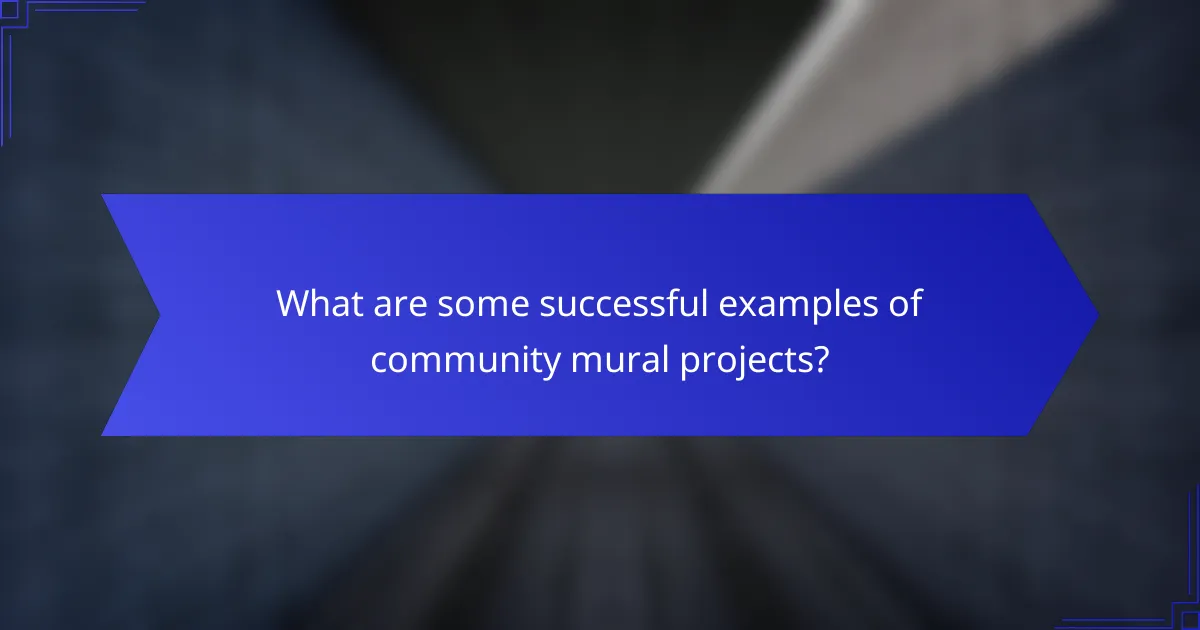
What are some successful examples of community mural projects?
Successful community mural projects enhance local culture, boost economic growth, and engage customers. These initiatives often transform public spaces, making art accessible while fostering community pride and attracting visitors.
Philadelphia Mural Arts Program
The Philadelphia Mural Arts Program is one of the largest public art programs in the United States, featuring over 4,000 murals throughout the city. It focuses on community engagement, employing local artists and involving residents in the design process to reflect the neighborhood’s identity.
This program not only beautifies urban spaces but also stimulates economic growth by attracting tourists and supporting local businesses. The murals often serve as landmarks, drawing visitors who contribute to the local economy.
Los Angeles Arts District murals
The Los Angeles Arts District is renowned for its vibrant street art scene, with numerous murals that showcase the work of both established and emerging artists. These murals are part of a broader effort to revitalize the area, turning it into a cultural hub that attracts art lovers and tourists alike.
Local businesses benefit from the increased foot traffic generated by mural tours, which often include guided walks. This engagement not only enhances visibility for shops and restaurants but also fosters a sense of community among residents and visitors.
Detroit’s Murals in the Market
Detroit’s Murals in the Market is an annual festival that brings together artists to create large-scale murals in the Eastern Market district. This initiative aims to revitalize the area while promoting local culture and artistry.
The festival encourages community participation and collaboration, with local businesses often sponsoring murals. This partnership helps to create a unique atmosphere that attracts visitors, ultimately driving economic growth in the surrounding area.

What challenges do community mural projects face?
Community mural projects often encounter challenges such as funding limitations, community engagement, and regulatory hurdles. These obstacles can hinder the successful execution and sustainability of the murals, impacting their intended benefits for economic growth and visibility.
Funding and Budget Constraints
Securing adequate funding is a primary challenge for community mural projects. Many rely on grants, donations, or sponsorships, which can be unpredictable. It’s essential to create a detailed budget that outlines all potential costs, including materials, artist fees, and permits.
To enhance funding prospects, consider organizing fundraising events or launching crowdfunding campaigns. Engaging local businesses for sponsorship can also provide financial support while fostering community ties.
Community Engagement and Support
Gaining community support is crucial for the success of mural projects. Without local buy-in, projects may face resistance or lack participation. Conducting surveys or hosting community meetings can help gauge interest and gather input on design ideas.
Involving community members in the mural creation process fosters ownership and pride, increasing the likelihood of project success. Consider workshops or collaborative painting sessions to encourage participation.
Regulatory and Permitting Issues
Navigating local regulations and obtaining necessary permits can pose significant challenges for mural projects. Each municipality has different rules regarding public art, which can affect project timelines and feasibility. Researching local laws early in the planning process is vital.
Engaging with local government officials can help clarify requirements and streamline the permitting process. Building relationships with regulatory bodies may also facilitate smoother approvals for future projects.



